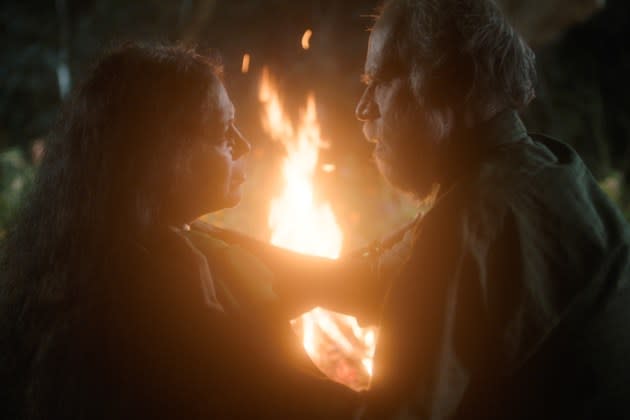‘In the Belly of a Tiger’ Review: A Spiritual Indian Drama Takes Aim at Capitalist Indignities

An occasionally surreal, consistently moving film that wrestles with religious imagery, Siddartha Jatla’s “In the Belly of a Tiger” frames the act of sacrifice as both deeply spiritual and regrettably pragmatic. This conundrum emanates from the story of a man who offers himself up to a hungry tiger if it means being able to feed his family, a tale Jatla uses to scrutinize the machineries of injustice. However, the writer-director eventually narrows his focus to a bittersweet romance, unfurling not only the foibles of contemporary caste and class, but the wistful joys and exultations crushed by their bootheels.
Although laced with gentle moments, the film begins with a stark close-up of an elderly man in the forest as he drenches himself in chicken’s blood. It’s a strange sight, but there turns out to be a tragic practicality to this makeshift ritual. The next day, his body is discovered in a nearby field, half-eaten by a tiger. Soon, politicians arrive at the local village to deliver empty sermons about compensation, but aspersions are cast on the dead man and his middle-aged son Ganesh (Nemchand), who are accused of concocting a suicide scheme for a quick payout. Desperation lingers in the air.
More from Variety
Meanwhile, the film’s central characters — kind elderly couple Bhagole (Lawrence Francis) and Prabhata (Poonam Tiwari), their pensive, widowered son Saharsh (Sourabh Jaiswar) and his mischievous daughters Parvati (Sonali) and Chatkila (Jyoti) — return to their village, having failed to find work in the big city. To make ends meet, Saharsh takes up a daily wage job at a local open-air brick factory, where he toils away under the callous auspices of a vile factory manager (Bhupendra Singh) who exploits the village’s most indebted residents. Saharsh’s co-workers include a young family of four (with a fifth on the way) whose kindness he tries desperately to reciprocate.
As rumors fly about how and why Ganesh’s father died, the movie’s harsh depictions of this economic reality are interrupted nightly by ornate religious stage performances centering the Hindu ur-deity Vishnu, the god of preservation. The presence of religious tradition looms large over events, calling into question the rigid order of caste and money foisted upon Saharsh’s family and peers — an order which every legal and social structure bends to preserve. On stage, Vishnu hears worshippers calling out to him from afar, though he seldom takes action. These distant voices may as well be the prayers of the villagers, who sit in open fields, eagerly awaiting his appearance each night.
The more Saharsh is forced to confront his economic predicament, the more visions of the past begin to materialize before him, allowing Jaiswar to dig deep into the character’s guarded vulnerabilities. Questions of how his family could possibly escape their circumstances are frequently broached, but after a while, things begin to seem increasingly hopeless. Their story begins bending toward a tragic conclusion that feels entirely inevitable, as though it were a premonition.
Rather than scrambling to arrive at its emotionally challenging conclusion, “In the Belly of a Tiger” takes an odd but effective structural turn. After moving swiftly from scene to scene, employing vignettes to weave a sense of gloom, the film spends much of its final third on a single conversation between Bhagole and Prabhata, as they debate the possibilities before them — or lack thereof — while reminiscing about their time together. The film, and the capitalist forces that be, practically force them to take stock of their entire lives over the course of a single evening.
This herculean task is made manageable by touches of lush surrealism, which Jatla expertly balances alongside the film’s naturalistic performances. Brief flashbacks to years and decades in the past not only paint a touching picture of the elderly couple’s lives together, but illuminate the degree to which their story has cross-pollinated and reflected upon the stories of their son, his daughters and the various other villages in their vicinity. Each visual repetition hammers home just how cyclical the village’s tragedies have become.
Physical spaces are rich with symbolism. The brick kiln, for instance, is rumored to be built on the site of a mass grave, as though it were fueled by the lives of the poor. Jatla, who serves as his own cinematographer, fills each frame with details and textures that gesture toward the ethereal but keep the story grounded. The film’s atmosphere, while hazy, feels weighed down — thanks in no small part to Shigeru Umebayashi’s heavy, echoing strings — even in the few moments Jatla uses radiant flourishes to keep hints of hope in the characters’ peripheries.
And yet, misery continues to trickle down. The probability of catharsis grows increasingly slim, despite the constant promises presented by spiritual beliefs. The resulting film — while largely morose, in spite of its occasional radiance — is a radically honest look at how unjust structures negotiate the value of bodies, and rob people of their dignity, even in death.
Best of Variety
Sign up for Variety’s Newsletter. For the latest news, follow us on Facebook, Twitter, and Instagram.
